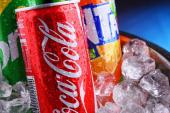Taxing Sugar-Sweetened Drinks Modestly Impacts BMI
This small but meaningful change seen in California may add up to a generational impact on consumption, but only time will tell.

California’s excise taxes on sugar-sweetened beverage (SSB), which first kicked off in 2015, thus far only have had a modest impact on body mass index (BMI) in the community, according to a new study. The data highlight the need to better understand how the taxes could be made more equitable to combat obesity.
Results from four cities that enacted such taxes impart no overall decrease in BMI, but there was a modest reduction in young adults in their 20s and 30s, women, and white individuals.
While the latter are a good sign, the researchers say the potential health benefits of the taxes may not be reaching those at highest risk for overweight or obesity and cardiometabolic conditions, as evidenced by a slight increase over the study period in the proportion of adults with overweight or obesity living in neighborhoods where > 20% of households live in poverty.
“Although SSB excise taxes were beneficial for certain demographic groups, current SSB excise taxes should be implemented in tandem with other interventions to improve weight-related outcomes for all,” Emily F. Liu, MPH (Kaiser Permanente Division of Research, Pleasanton, CA), the study’s lead author, told TCTMD.
In 2015, Berkeley implemented a $0.01 per ounce excise tax on SSBs, including soda, sports drinks, and fruit-flavored beverages, which was the first tax of its kind in the United States. This step was followed by three other California cities: Albany, Oakland, and San Francisco. US cities with similar excise taxes include Boulder, CO; the District of Columbia; Philadelphia, PA; and Seattle, WA.
Berkeley comes out ahead of the other California cities with excise taxes at this point, with a greater decline in BMI overall. “A longer timeline might be one of many reasons we saw a reduction in adult BMI in Berkeley,” Liu said in an email. “However, there were also differences in the allocation of tax revenue to health-promoting infrastructure and programs by each city.” In Albany, Berkeley, and San Francisco, 100%, 92%, and 79%, respectively, of the tax revenue from SSBs went to health-related projects, while in Oakland, it was divided between human and community capital and health.
Commenting for TCTMD, Christina A. Roberto, PhD (Center for Food and Nutrition Policy, University of Pennsylvania, Philadelphia), said the data that are emerging provide a clearer picture of how these taxes can improve health.
“To me, this is really a no-brainer policy because we have very robust data showing that it gets people to drink fewer of these drinks. We know it generates revenue and that revenue is largely being spent to advance other public health initiatives,” she said. “So those are all good things, and now we have data suggesting they might also improve health.”
Roberto co-authored a recent paper in The Lancet Regional Health—Americas that showed limited evidence of a decrease in BMI and obesity prevalence in Philadelphia 3 years after implementing a beverage tax .
“To ask one policy to move the needle on health is a really tall order, so the fact that we see even these modest improvements is incredible,” said Roberto. “I don't want to overstate [because] they're not revolutionizing health, but small, meaningful changes from one policy targeting just one drink category is kind of a big deal.”
BMI Changes
For the study, published recently in JAMA Network Open, Liu and colleagues analyzed data on 1,044,272 people (mean age 39.7 years; 55.6% women) enrolled in the Kaiser Permanente healthcare system who resided in one of the four California cities with SSB taxes put in place 4 to 6 years prior. A group of 865,343 participants (mean age 39.9 years; 55.5% women) living in 40 cities without SSB taxes served as a control population.
More than half of the individuals in each group had overweight or obesity at study entry, but the proportion of residents with overweight or obesity was lower overall at baseline in the four cities with SSB taxes compared with cities without excise taxes. Other differences between cities with and without SSB taxes included a greater proportion of Black and white adults in relation to Hispanic adults as well as fewer individuals on Medicaid.
Overall, the change in mean BMI of -0.13 in the four cities was not significant in comparison to control cities, with no change seen in the proportion of adults with overweight or obesity.
However, reductions in BMI were significant compared with controls among those ages 20 to 25 years at baseline (−0.30; 95% CI −0.51 to −0.08) and those ages 26 to 39 at baseline (−0.19; 95% CI −0.37 to −0.20). Other groups with BMI reductions compared with controls were women (−0.19; 95% CI −0.26 to −0.11), and White adults (−0.19 95% CI −0.35 to −0.04).
When Berkeley alone was compared against control cities, the change in mean BMI was −0.16, with the most pronounced decrease seen in year 5 after the taxes were implemented.
According to Liu and colleagues, the changes—despite being small—are going in the right direction, with the point estimate for overall change in BMI roughly equivalent to a 0.8-lb reduction in weight for a 5′4” woman with a BMI of 27. They also estimate that a mean reduction of -0.19 among adults in California over 10 years has the potential to prevent more than 260,000 cases of obesity by 2032.
To TCTMD, Liu said that given the lack of a significant population-wide reduction in BMI, coupled with data from other cities showing no impact of the tax on groups that tend to be both high SSB consumers and have the highest prevalence of overweight, obesity, diabetes, and CVD, “SSB excise taxes are not a stand-alone intervention to address overweight and obesity in adults.”
Roberto added that the excise taxes are what many public policy experts hope is just the first step in consumption tax on as a widespread health policy initiative.
”We should really be thinking about expanding them to unhealthy ultraprocessed junk food, and of course, coupling them with other types of interventions, particularly things that will also help make healthy food more affordable,” she said. ”So, if you're going to tax sugary drinks, can we make water cheaper, for example?”
While it’s hard to say just how far into the future it will be before consumption taxes translate to real shifts in health, Roberto said she wouldn’t rule out their ability to effect generational change.
“We have a generation of kids growing up in places like Berkeley where they may now be drinking less soda and not forming habits around [sugary drinks] that persist into adulthood,” she said. “Changing eating habits is hard. It’s an intractable problem, . . . but this is one of our most effective interventions to date.”
L.A. McKeown is a Senior Medical Journalist for TCTMD, the Section Editor of CV Team Forum, and Senior Medical…
Read Full BioSources
Liu EF, Young DR, Sidell MA, et al. City-level sugar-sweetened beverage taxes and changes in adult body mass index. JAMA Network Open. 2025;Epub ahead of print.
Disclosures
- Liu and Roberto report no relevant conflicts of interest.





Comments